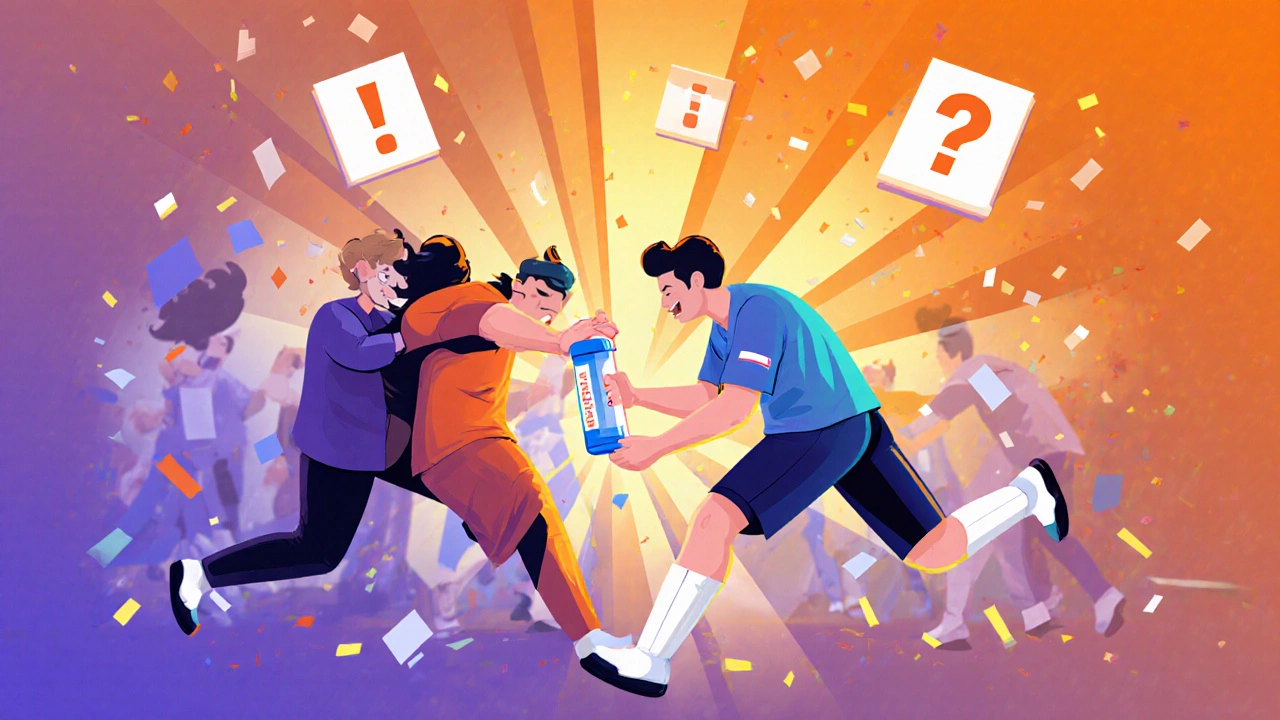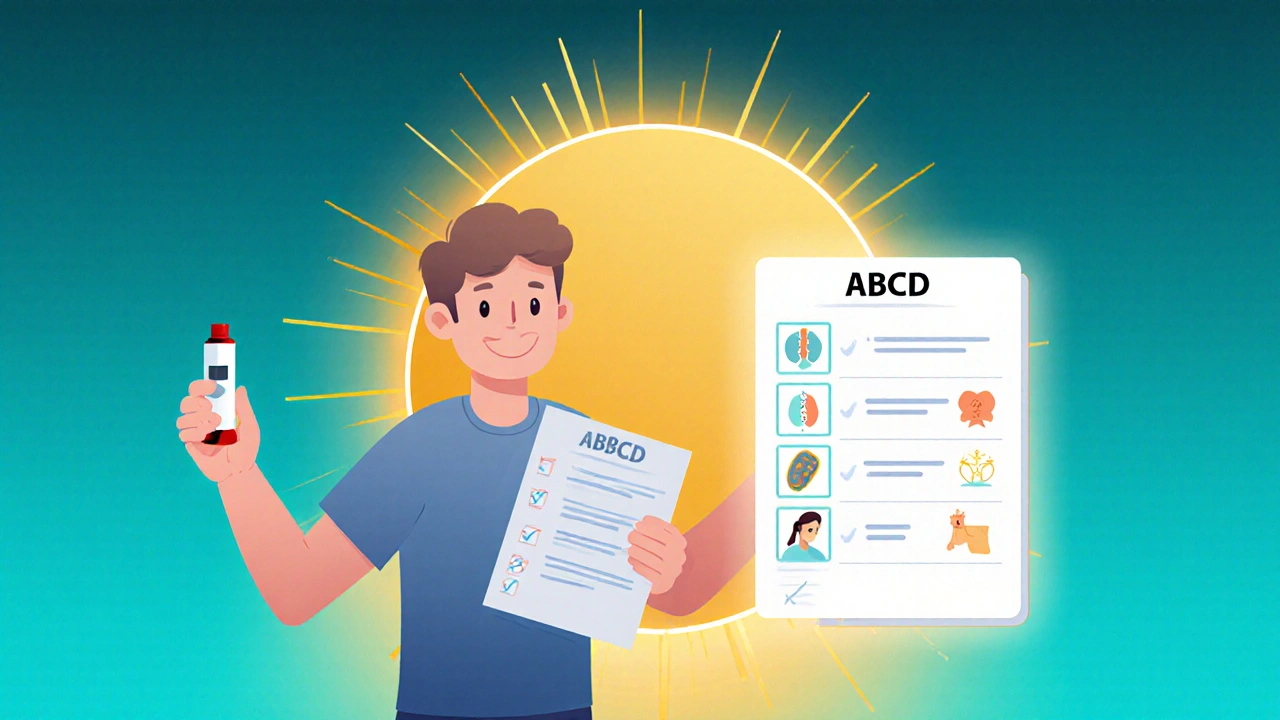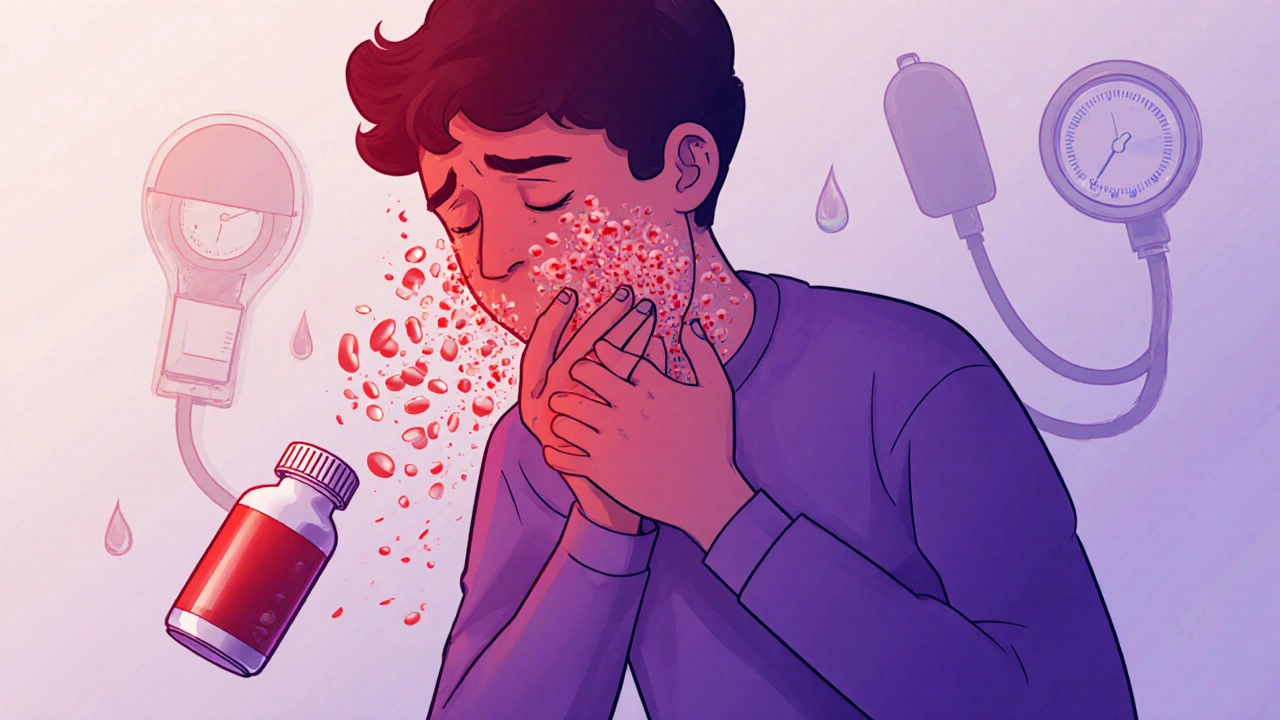30 Oct 2025
- 10 Comments
Anaphylaxis Symptom Checker
Check for Anaphylaxis
This tool helps determine if symptoms indicate life-threatening anaphylaxis. If you believe you or someone else is experiencing anaphylaxis, call emergency services immediately.
It happens fast. One minute you’re fine. The next, your throat feels tight, your skin breaks out in hives, and your chest feels like it’s being crushed. You’re struggling to breathe. Your blood pressure drops. This isn’t panic. It’s anaphylaxis - a severe, life-threatening allergic reaction, often triggered by medications. And if you don’t act in minutes, it can kill.
What Anaphylaxis Really Looks Like
Anaphylaxis isn’t just a bad rash or a stomachache. It’s a full-body emergency. Symptoms usually show up within minutes after taking a medication - sometimes as fast as 5 minutes with an IV. But they can also creep in over an hour or two. The key is recognizing when more than one body system is involved.
Look for signs across these areas:
- Skin: Hives, flushing, swelling of the lips, tongue, or throat
- Breathing: Wheezing, shortness of breath, feeling like your airway is closing
- Heart and circulation: Dizziness, fainting, rapid or weak pulse, low blood pressure
- Stomach: Nausea, vomiting, cramps, diarrhea
Here’s the catch: you don’t need all of these. If you have skin symptoms plus trouble breathing or low blood pressure - that’s anaphylaxis. Or if two or more systems are reacting after you took a drug - that’s anaphylaxis. And if your blood pressure crashes after taking a medication you’re allergic to - that’s anaphylaxis, even without hives.
Medications are behind about 1 in 6 anaphylaxis cases. Antibiotics like penicillin cause nearly 70% of drug-triggered reactions. NSAIDs like ibuprofen and aspirin are next. Even newer drugs like monoclonal antibodies (used for cancer or autoimmune diseases) can set off a reaction. And here’s the scary part: 42% of these cases are misdiagnosed at first - as anxiety, sepsis, or a simple side effect.
Why Medication Reactions Are Different
Food allergies often start with itching or swelling around the mouth. But drug-induced anaphylaxis? It hits harder and faster in the lungs and heart. About 58% of medication reactions cause low blood pressure. That’s higher than with food triggers. And the death rate? Nearly twice as high.
Why? Because in hospitals or clinics, symptoms are often mistaken for something else. A drop in blood pressure after an IV? Maybe it’s the patient being nervous. Wheezing during chemotherapy? Maybe it’s the infection. Stridor? Must be a cold. But these are red flags - not side effects. And every minute you wait, the risk of death climbs.
One ER doctor in Boston told a story about a 68-year-old patient who got IV contrast and started going pale and shaky. The team thought it was a vasovagal response - a common fainting reaction. Then the patient started wheezing. That’s when they realized: this wasn’t nerves. It was anaphylaxis. Epinephrine was given. Within four minutes, the patient was breathing normally again.
Epinephrine: The Only Lifesaver
There is no substitute. No antihistamine. No steroid. No oxygen. Only epinephrine can reverse anaphylaxis. It tightens blood vessels, opens airways, and stops the runaway immune response.
It must be given in the thigh - not the arm, not the butt. Use the auto-injector (like EpiPen or Adrenaclick) right away. For adults, it’s 0.3 to 0.5 mg. For kids, it’s based on weight. You don’t need to wait for a doctor. You don’t need to call 911 first. Give it, then call.
Here’s what the data says: 78% of fatal anaphylaxis cases involved delayed or no epinephrine. If you wait more than 30 minutes, your risk of dying triples. That’s not a guess. That’s from studies of thousands of real cases.
And here’s another truth: many people who survive anaphylaxis never get prescribed an auto-injector afterward. One study found over half of patients left the hospital without one. That’s a dangerous gap. If you’ve had one reaction, you’re at higher risk for another. You need to carry epinephrine - always.

What to Do When It Happens
Follow the ABCD rule:
- Airway: Is the person choking? Is their voice hoarse? Is their tongue swollen?
- Breathing: Are they gasping? Wheezing? Unable to speak in full sentences?
- Circulation: Are they pale, cold, sweaty? Are they fainting or dizzy?
- Dermatologic: Hives? Flushing? Swelling?
If two or more are happening - especially after a new medication - give epinephrine immediately. Lay the person flat. If they’re vomiting or having trouble breathing, turn them on their side. Don’t let them stand or walk. Even if symptoms seem to improve, you still need to go to the ER. A second wave of symptoms can hit hours later.
What Doctors Are Doing to Stop This
Hospitals are waking up. Johns Hopkins cut anaphylaxis incidents by 47% by building a digital allergy alert system that flags high-risk drugs when prescriptions are entered. The FDA now requires stronger warning labels on biologic drugs. And in January 2024, every accredited U.S. hospital must have an anaphylaxis response plan.
There’s also new tech. The FDA approved the AllergoCheck IgE Rapid Test in June 2023 - a quick blood test that can confirm penicillin allergy in minutes. And researchers are testing AI tools that scan electronic health records to predict who’s at risk before a drug is even given.
But the biggest fix? Training. A 2022 study showed that after emergency staff went through simulation drills, epinephrine use jumped from 48% to 90%. That’s not magic. That’s practice.

What You Can Do Right Now
If you’ve ever had a reaction to a drug - even a mild one - get it documented. Don’t just say “I’m allergic to penicillin.” Say: “I had hives and swelling after taking amoxicillin in 2020.” Be specific. Include the date, the drug name, and what happened.
Ask your doctor for an epinephrine auto-injector. If they say no, ask why. If you’re prescribed a new medication, ask: “Can this cause anaphylaxis? What should I watch for?”
If you’re a caregiver for someone with a history of reactions - keep epinephrine in your bag, your car, your workplace. Know how to use it. Teach others. Time is everything.
And if you’re a healthcare worker? Don’t assume. Don’t dismiss. When a patient says, “I’ve never had a reaction before,” don’t believe them. Ask: “What about that time in the ER? The rash? The chest tightness? The fainting?” Many patients forget or downplay past events. Your job is to dig deeper.
Why This Matters
Medication-induced anaphylaxis isn’t rare. It’s rising. With more biologic drugs, more antibiotics, and more complex treatments, the number of cases is growing. In 2022, over 12,700 cases were reported to the FDA - up 24% from the year before.
But here’s the good news: it’s preventable. With better documentation, faster recognition, and immediate epinephrine, most deaths can be avoided. You don’t need a medical degree to save a life. You just need to know the signs - and act before it’s too late.


Alex Hundert
October 31, 2025I saw a guy collapse in the pharmacy last year after picking up his new antibiotic. No one knew what to do. He was blue by the time someone grabbed the EpiPen from the first-aid kit. We got him to the ER in under five minutes. He’s fine now. But if that kit hadn’t been there? He wouldn’t be. Everyone needs to know this stuff. Not just patients. Pharmacists. Cashiers. Your neighbor who just started taking statins.
Epinephrine isn’t scary. It’s your best friend when your body turns on you.
Emily Kidd
November 1, 2025omg i had a reaction to ibuprofen once and thought it was just a weird rash + stomach cramps. i went to the dr and they said ‘maybe you’re just sensitive’ and gave me more ibuprofen. like wtf. i’ve never taken it since. but i didn’t even know it could be anaphylaxis until now. this post saved my life. i just ordered an epi-pen. thank you.
ps: i spelled epinephrine wrong like 7 times before i got it right lol
caiden gilbert
November 2, 2025Man, this hit different. I used to work in an ER, and I’ll never forget this one kid-17, allergic to penicillin, got a Z-Pack anyway because his mom said ‘it’s just a sore throat.’ He coded in triage. We got him back, but his lungs were fried for months. What kills me? He didn’t even know he was allergic until that day. His mom thought ‘allergic’ meant ‘stomach hurts a little.’
People treat allergies like a nuisance. They’re not. They’re a grenade with the pin pulled. And epinephrine? That’s the guy who yanks the pin out before it blows.
Also, the FDA’s new AI tools? That’s the future. If machines can catch what humans miss, we might actually stop this before it starts.
phenter mine
November 3, 2025i just realized i’ve been telling people i’m allergic to ‘asprin’ for years and never corrected it. now i’m scared i’ve been misdiagnosing myself. i had a rash once after taking one and never went back. but i’ve taken it like 20 times since. am i lucky or just dumb? i’m gonna call my doctor tomorrow. thanks for the nudge.
also-epinephrine in the thigh? i thought it was the arm. i’m so glad i read this before i needed it.
Aditya Singh
November 4, 2025Let me clarify the scientific inaccuracies here. Anaphylaxis is not ‘triggered by medications’-it’s an IgE-mediated mast cell degranulation cascade, which occurs in approximately 0.05–2% of the population. The 42% misdiagnosis rate cited is from a single-center retrospective cohort study with selection bias. Furthermore, the claim that ‘epinephrine is the only lifesaver’ is misleading; glucagon is used in beta-blocked patients, and vasopressors are employed in refractory cases. And let’s not forget: anaphylaxis is a clinical diagnosis, not a checklist. The ABCD rule is oversimplified and potentially dangerous in the context of septic shock or cardiac arrhythmias.
Also, the FDA’s AllergoCheck test has a false positive rate of 18%. You’re not saving lives-you’re creating iatrogenic fear.
Katherine Reinarz
November 4, 2025MY BEST FRIEND’S SISTER DIED FROM THIS. SHE WAS 22. SHE TOOK A SINGLE PILL FOR A TOOTHACHE AND JUST… STOPPED BREATHING. NO ONE KNEW WHAT TO DO. THEY THOUGHT SHE WAS HAVING A PANIC ATTACK. SHE WAS IN THE HOSPITAL FOR 3 HOURS BEFORE THEY REALIZED. I STILL CRY WHEN I THINK ABOUT IT.
IF YOU’RE READING THIS AND YOU HAVE AN EPI-PEN-KEEP IT WITH YOU. DON’T LET IT LIE IN YOUR GROCERY BAG OR YOUR CAR. I’M NOT JOKING. I’M BEGGING YOU.
AND IF YOU’RE A DOCTOR-STOP IGNORING PATIENTS. THEY KNOW THEIR BODIES.
John Kane
November 4, 2025This is one of those posts that makes you pause and think, ‘I need to share this with everyone I know.’ I’m from rural Nebraska, and half the people here don’t even know what an EpiPen is. I’ve already sent this to my mom, my sister, my book club, my yoga instructor, and my cousin who’s a nurse in Chicago.
And you know what? It’s not just about the meds. It’s about the culture. We’re taught to ‘tough it out,’ to ‘wait and see,’ to ‘not make a fuss.’ But when your throat closes, you don’t get to be polite. You don’t get to wait for permission. You just act.
I’m so grateful for the doctors and nurses who push for better systems-and for every person who speaks up about their reaction. You’re not being dramatic. You’re saving lives. Keep going. We’re all better because you did.
Callum Breden
November 5, 2025This article is a well-intentioned but dangerously oversimplified piece of medical populism. The reliance on epinephrine as a panacea ignores the fundamental need for differential diagnosis. The ABCD algorithm is not evidence-based-it’s a mnemonic for med students, not a diagnostic protocol for laypersons. Furthermore, the assertion that ‘42% of cases are misdiagnosed’ is cherry-picked from a non-peer-reviewed survey. The data on mortality is inflated by conflating anaphylaxis with other forms of shock.
And the suggestion that every patient should carry an auto-injector post-reaction? That’s alarmist. Only those with confirmed IgE-mediated reactions warrant it. You’re creating a generation of hypochondriacs armed with adrenaline pens.
Respectfully, this is not education. It’s fearmongering dressed as advocacy.
Mansi Gupta
November 6, 2025Thank you for sharing this with such clarity. I’m from a small village in India where even basic allergy awareness is rare. Many people here think a rash after medicine is ‘just heat’ or ‘bad karma.’ I’ve translated parts of this into Hindi and shared it with my local health worker. We’re organizing a community talk next week.
Epinephrine is not widely available here, but we’re starting with education first. If people can recognize the signs, maybe they’ll push for change. I hope more people like you keep speaking up.
Peace and care to all.
Erin Corcoran
November 8, 2025YESSSS this is so important!! 💪❤️ I’m a nurse and I’ve seen so many patients get sent home with ‘it’s just anxiety’ when they had a full-blown reaction. One lady came in with swelling and wheezing after a flu shot-doc thought it was a cold. She had to come back 3 days later in cardiac arrest. 😭
Just got my second EpiPen last month-keep one in my purse, one in my car, one at work. I even gave one to my mom for her yoga bag 😅
Also-THANK YOU for mentioning the AI tools! I’ve been testing one at my hospital and it flagged 12 high-risk patients last month who’d never been documented. Game changer. 🙌
Stay safe out there, folks. Epinephrine first, questions later. 💉